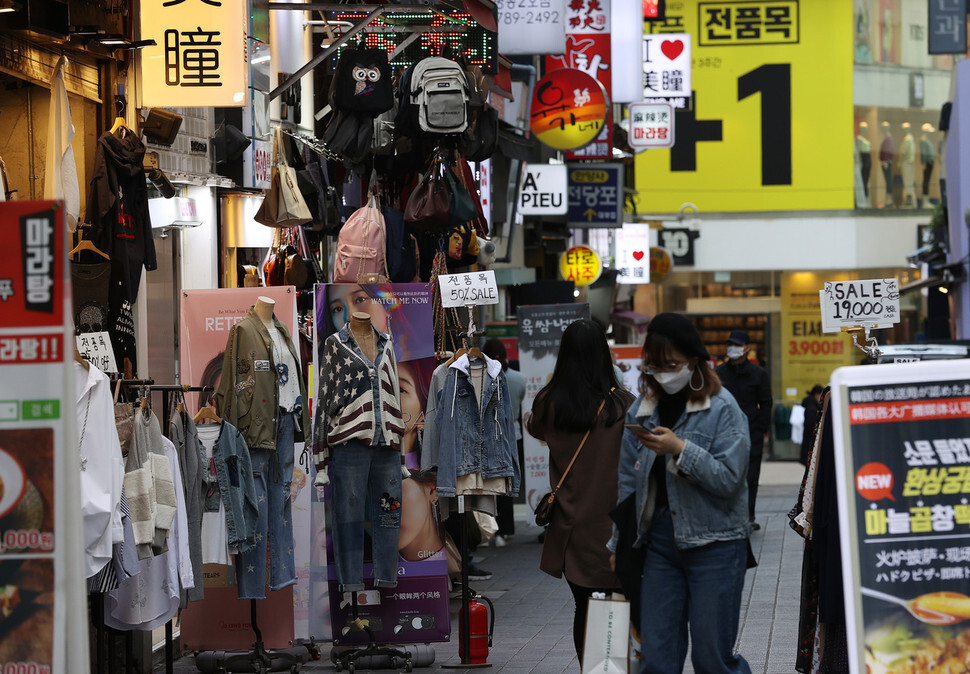hankyoreh
Links to other country sites 다른 나라 사이트 링크
[Editorial] S. Korean government needs to help people stay economically afloat during coronavirus crisis

The South Korean government is leaning toward providing basic disaster allowances in the COVID-19 crisis on a selective basis, to households with middle to low incomes, rather than to all South Koreans. The goal of this disaster aid is to help people who have been hurt by the COVID-19 pandemic, while also energizing the economy by encouraging consumption. We regard emergency livelihood aid as a timely idea: it enjoys a broad public consensus, and several local governments are already organizing such measures on their own. We hope the central government will quickly implement this kind of plan, creating a life jacket to help the nation weather the crisis.
In the third meeting of the emergency economic council on Mar. 30, presided over by South Korean President Moon Jae-in, the South Korean government is reported to have finalized a plan to provide basic disaster allowances. Media reports indicate that the Ministry of Economy and Finance is considering a plan to give aid to 10 million households making less than the median income (defined as the midpoint of a series of household incomes arranged from highest to lowest), with a four-person household receiving 1 million won (US$816). That aid package would cost 7-8 trillion won (US$5.71-6.52 billion). The Democratic Party, on the other hand, has proposed paying 500,000 won (US$408) per person to 70-80% of citizens, which would add up to 18-20 trillion won (US$14.68-16.31 billion).
The government’s plan is to focus assistance on low-income earners, the ones who are suffering the most, while taking into account the fiscal burden. That contrasts with the ruling party’s plan, which seeks to increase funding to extend aid to as many people as possible in order to stimulate the economy. But the common thread running through both these plans is that they would provide one-time selective aid to people in the middle and lower classes, rather than all citizens.
That’s similar to the plan devised by Seoul, which has decided to provide 1,177,000 households below the median income that didn’t benefit from the government’s supplemental budget with 300,000-500,000 won (US$245-408), depending on the number of household members (costing 327.1 billion won, or US$266.81 million, altogether). The plan adopted by Gyeonggi Province is conceptually closer to basic income, paying out 100,000 won (US$82) per person to all 13.26 million (US$10,816) people living in the province (costing a total of 1.3 trillion won, or US$1.06 billion).
On Mar. 29, the Justice Party proposed paying 1 million won (US$816) to everyone in the country, and the Open Democrats called for giving 500,000 won (US$408) to all adults aged 18 and above. The United Future Party had been criticizing these proposals as “populist schemes aimed at winning the parliamentary elections,” but more recently it has kept quiet, apparently having realized, belatedly, the severity of this crisis.
During the emergency economic council’s second meeting, last week, Moon stressed the need to “reach a quick decision in the third meeting about effective ways to provide livelihood support.” While the government needs to act with caution, dragging out its decision might only multiply confusion. We urge the government, after reaching a rational decision about who will receive assistance, and how much, taking into account the plan’s efficacy and burden on the budget, to execute that plan swiftly and boldly.
Please direct comments or questions to [english@hani.co.kr]

Editorial・opinion
![[Column] Life on our Trisolaris [Column] Life on our Trisolaris](https://flexible.img.hani.co.kr/flexible/normal/500/300/imgdb/original/2024/0505/4817148682278544.jpg) [Column] Life on our Trisolaris
[Column] Life on our Trisolaris![[Editorial] Penalties for airing allegations against Korea’s first lady endanger free press [Editorial] Penalties for airing allegations against Korea’s first lady endanger free press](https://flexible.img.hani.co.kr/flexible/normal/500/300/imgdb/original/2024/0502/1817146398095106.jpg) [Editorial] Penalties for airing allegations against Korea’s first lady endanger free press
[Editorial] Penalties for airing allegations against Korea’s first lady endanger free press- [Editorial] Yoon must halt procurement of SM-3 interceptor missiles
- [Guest essay] Maybe Korea’s rapid population decline is an opportunity, not a crisis
- [Column] Can Yoon steer diplomacy with Russia, China back on track?
- [Column] Season 2 of special prosecutor probe may be coming to Korea soon
- [Column] Park Geun-hye déjà vu in Yoon Suk-yeol
- [Editorial] New weight of N. Korea’s nuclear threats makes dialogue all the more urgent
- [Guest essay] The real reason Korea’s new right wants to dub Rhee a founding father
- [Column] ‘Choson’: Is it time we start referring to N. Korea in its own terms?
Most viewed articles
- 1New sex-ed guidelines forbid teaching about homosexuality
- 260% of young Koreans see no need to have kids after marriage
- 3[Column] Life on our Trisolaris
- 4OECD upgrades Korea’s growth forecast from 2.2% to 2.6%
- 5Presidential office warns of veto in response to opposition passing special counsel probe act
- 6Months and months of overdue wages are pushing migrant workers in Korea into debt
- 7[Guest essay] Maybe Korea’s rapid population decline is an opportunity, not a crisis
- 8Trump asks why US would defend Korea, hints at hiking Seoul’s defense cost burden
- 9[Editorial] Penalties for airing allegations against Korea’s first lady endanger free press
- 10Japan says it’s not pressuring Naver to sell Line, but Korean insiders say otherwise